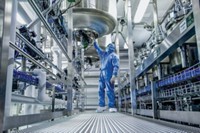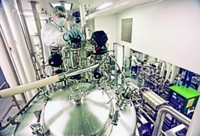Advertisement
Grab your lab coat. Let's get started
Welcome!
Welcome!
Create an account below to get 6 C&EN articles per month, receive newsletters and more - all free.
It seems this is your first time logging in online. Please enter the following information to continue.
As an ACS member you automatically get access to this site. All we need is few more details to create your reading experience.
Not you? Sign in with a different account.
Not you? Sign in with a different account.
ERROR 1
ERROR 1
ERROR 2
ERROR 2
ERROR 2
ERROR 2
ERROR 2
Password and Confirm password must match.
If you have an ACS member number, please enter it here so we can link this account to your membership. (optional)
ERROR 2
ACS values your privacy. By submitting your information, you are gaining access to C&EN and subscribing to our weekly newsletter. We use the information you provide to make your reading experience better, and we will never sell your data to third party members.
Pharmaceuticals
Asia Advances Biosimilars
Companies in South Korea, China, and India are scrambling to market generic biopharmaceuticals
by Rick Mullin
August 22, 2011
| A version of this story appeared in
Volume 89, Issue 34

Conference session attendees at the Biotechnology Industry Organization’s (BIO) annual meeting in Washington, D.C., in June heard much discussion of the Food & Drug Administration’s protracted efforts to arrive at a regulatory pathway to approving biosimilars, as generic versions of biologic drugs are known. Western companies interested in the market expressed a distinct wait-and-see attitude. In the exhibit hall, however, “Biosimilars” was emblazoned on the booth banners of Chinese, South Korean, and Indian companies, many of which have biosimilar candidates in advanced stages of development if not already on the local market.
Asian producers, it would seem, are making good use of the regulatory latency period in the U.S. to emerge as the leaders in the global market for biosimilars. It’s a market that consultancy Decision Resources forecasts will hit annual sales of $14 billion for versions of 20 major drugs or drug classes by 2019.
Under a big red banner reading “Biosimilars & New Biologics!” representatives from South Korea’s Celltrion discussed generic versions of Genentech’s Herceptin breast cancer drug and Centocor Ortho Biotech’s Remicade, a treatment for arthritis and Crohn’s disease. Both generic drugs are in Phase III clinical trials.
In the next aisle, the Zydus division of Cadila Healthcare, an Indian company, promoted its biosimilar versions of the Amgen cancer drugs Neupogen and Neulasta, which Zydus has commercialized in India. Zydus also plans to introduce a version of Rituxan, Roche’s non-Hodgkin’s lymphoma drug, in the Indian market. Nearby, Samsung, the big South Korean conglomerate, introduced a new biosimilars venture.
Binu Philip Thomas, general manager of business development at Zydus, said his firm anticipates bringing its biosimilar products to market in the U.S. once a clearer drug approval pathway emerges. The firm came to BIO to lay the groundwork. “We are looking for big pharma partnerships, and we have a lot of leads from meetings here,” he said. “Everyone is looking to get involved in partnerships.”
The strong show of Asian biosimilars suppliers at BIO comes on the heels of new partnerships between U.S. drug and biotech firms with suppliers in Asia. Merck & Co., for example, signed on with Hanwha Chemical, a South Korean supplier. Quintiles has a deal with Samsung. Pfizer, which has stated plans to enter the biosimilars market in a big way, signed an agreement last October with Biocon to license generic insulin for sale in India.
Although deals are certainly being made in the West—Lonza will manufacture biosimilars for Teva Pharmaceutical Industries in a joint venture, and Merck acquired a biosimilars program from Insmed, a New Jersey-based drug development firm—the drug industry has its eyes on partnerships in emerging markets.
Andrew Merron, director of the biosimilars adviser service at Decision Resources, said Asian producers are making headway. But given the complexity of large-molecule therapeutics, he questions whether products launched in emerging markets will be launched as easily in the U.S. Much will depend on regulatory guidelines still being finalized.
The European Medicines Agency issued regulatory guidelines for introducing biologics in Europe in 2006, and the agency recently published draft guidance specific to biosimilar monoclonal antibodies, Merron said. The World Health Organization has issued guidance similar to EMA’s.
Merron points to a recent article in the New England Journal of Medicine (DOI: 10.1056/NEJMp1107285), coauthored by Janet Woodcock, director of FDA’s Center for Drug Evaluation & Research, indicating that FDA will to some extent model guidance after EMA/WHO documents, but that the U.S. approach “will not be one size fits all.” Separate clinical regimens will likely emerge for individual drugs or drug classes.
Many Asian producers are planning to sell locally now and later undertake the clinical trials necessary to enter Western markets, Merron said. Despite regulatory uncertainties, he added, there are immediate benefits to the partnerships being formed between Western drug companies and Asian biosimilars producers. The Asian firm gains the credibility of a big pharma partnership, and the Western firm can penetrate emerging markets with lower regulatory hurdles as it develops a track record with biosimilars.
For Merck, the hookup with Hanwha also has the benefit of giving the drug firm exactly what it was looking for in a biosimilar version of Amgen’s anti-inflammatory drug Enbrel, according to Michael Kamarck, president of Merck BioVentures. “The fact that it came from Asia is a coincidence,” he said. “It was not developed for Asian markets.”
Kamarck is dismissive of the notion that Asia is emerging as a breadbasket for biosimilars. Merck is developing its own biosimilars, including MK-4214 and MK-6302, generic versions of Amgen’s Neupogen and Neulasta, respectively, that it bought from Insmed in 2009.
The Merck executive and other sources acknowledge, however, that South Korean firms are making significant headway on biosimilars, partly on the basis of government investment in the sector. The Korean government has stated that it is targeting a 22% share of the global market in biosimilars.
In India, several firms are developing biosimilars or seeking entry into the market through partnerships. Cipla, for example, launched a joint venture with Shanghai-based Biomabs called MabPharm. Yusuf Hamied, chief executive officer of Cipla, said the venture hopes to launch biosimilar versions of Herceptin, Avastin, Enbrel, and Rituxan in India over the next two years.
Xu Shengping, CEO of Biomabs, said his firm has several of its own biosimilars, all monoclonal antibodies, in late-stage clinical development. Biomabs is also involved in a partnership with a company that has introduced a biosimilar of Enbrel in China. “Our main focus will be on the domestic markets, which are the fastest-growing markets in the world,” Xu said.
Quintiles’ investment in Samsung attests to the Western industry’s confidence in the growth potential of emerging markets. The firm put down $30 million for a 10% stake in the conglomerate’s new biosimilars venture, which hopes to commercialize biosimilar drugs by 2016.
The South Korean company also will provide contract manufacturing services to other producers in the region, according to Jeanne Hecht, vice president of sales and strategic planning in Asia for Quintiles. Hecht notes that the joint venture with Samsung is Quintiles’ first significant investment in manufacturing since it sold its manufacturing services business to Aptuit in 2005 in order to concentrate on clinical-trial services.
Quintiles has no plan to provide its clinical services in conjunction with Samsung’s biosimilars contract manufacturing, Hecht avows. “We are investing because we think there is a healthy return,” she said. And that return is likely to come from business in emerging markets. “Asia is definitely the breadbasket for biosimilars,” she said. “In many areas, folks can’t afford the cost of innovator compounds.”
Geoffrey S. Eich, director of regulatory affairs at Amgen and executive director of a new business unit exploring biosimilars, is not as convinced about the importance of Asia in biosimilars. “I don’t view biosimilars as an Asian phenomenon,” he said. “It’s a health care phenomenon more than anything else. It also stems from a general maturation of biotechnology itself.”
As the world’s largest biotech drug company, Amgen is seeing its products targeted by biosimilars producers at home and abroad. The company certainly has the expertise to pursue its own biosimilars production, Eich said, and it has convened a “small group of experts to look at biosimilars and understand what we should do.” He said the company will likely be involved in the market in some way by 2015.
A biotech executive speaking off the record at the BIO conference said many producers are following Amgen’s course of monitoring regulatory developments and gauging the science and manufacturing requirements for launching biosimilars businesses. Others are clearly going after the market more aggressively. Either way, in his view, the development of biosimilars production is likely to be another chapter in the book of East versus West in the pharmaceutical industry. “You know where they are going to come from,” he said. “Asia.” ◾




Join the conversation
Contact the reporter
Submit a Letter to the Editor for publication
Engage with us on Twitter